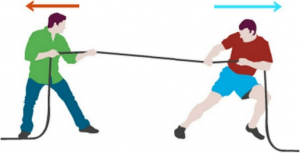Force
A variety of forces are investigating to show that forces can change either with the shape of an object or its motion. Both balanced and unbalanced forces.
What is a Force?
Force is defined as the pull or push which produces or tends to produce, destroys or tends to destroy motion in a body, increases or decreases the speed of the body or changes its direction of motion. Therefore, Force is an external or internal agent present to influence the natural state of motion of an object.

Classification of Forces: Based on the nature of the interaction between two bodies, forces can be classified into two main categories.
Contact Forces: Contact force is the force that act between the bodies in contact with each other.
Types of Contact Forces:
1. Friction: It is a force that acts between bodies in contact with each other along the surface of contact and it opposes relative motion (or tendency of relative motion) between the two bodies.
2. Spring Force: Force in an extended spring is proportional to the magnitude of extension.
F α x in magnitude, but opposite in direction.
So, F = – kx.
Where,
k = Spring Constant,
x = Elongation or Compression.
3. Tensional Force (T): When a string, thread or wire is held tight, the ends of the string or thread pull on whatever bodies are attached to them in direction of the string. This force is known as Tension. If the string is massless, then the tension T has the same magnitude at all point throughout the string. The direction of tension is always from the point of attachment to the body.
4. Weight (W): It is a field force, the force with which a body is pulled towards the centre of the earth due to its gravity. It has the magnitude mg, where m is the mass of the body and g is the acceleration due to gravity.
5. Normal reaction: When a body exerts a force on another, the second provides a reaction which acts perpendicular to the surface of 2nd body.
Non – Contact Forces: Forces which come into existence without any physical contact between the bodies. These forces are due to some inherent characteristics of the body.
Types of Non – Contact Forces:
1. Magnetic Forces (FMagnetic): Forces which come into play between two bodies due to their magnetic characteristics. Their direction also depends upon the nature of magnetic polarity acquired by the body. In mechanics we shall only deal with gravitational forces from this category.
2. Gravitational Forces (Fg): This is due to the gravitation attraction between two bodies. If we deal with cases of attraction due to earth, this force is always directed downwards.
3. Electrical Forces (FElectrical): These forces are due to the charges present on the two bodies. The direction of these forces depends upon the type of charges on the two interacting bodies.
